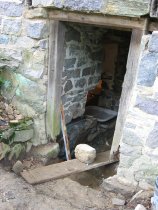Photo Record
Images

Metadata
Collection |
DeTurk |
Title |
Unrestored kitchen doorway |
Archive Number |
DTR09PH42 |
Description |
East cellar doorway prior to replacement of door-frame and masonry restoration. Restoration of the doorway and kitchen floor to their original elevations {1}, which are only marginally higher than the flood levels of the Creek and the high water table, will require diversion and mitigation measures to minimize water incursion. A stairwell from the restored modern grade to the original sill, protected by a new retaining wall along its northern perimeter, will include grated channel drains at two levels: one in the lower landing, to protect the sill from surface runoff and discharge the rising water table through an inlet in the southern end-cap of the basin; the second drain in the middle landing will intercept some of the runoff down the stairway from the upper grade and the runoff from the restored doorway hood [this channel is centered under the planned location of drip-edge of the shed-form hood’s roof]. To the left inside the doorway is a cantilevered segment of the root-cellar vault abutment wall [above mixing pan], shown in stable position over the temporary cavity, supported in part by the "centering" frame scribed under the vault ceiling ["intrados"] during restoration [see DTR09PH130--1001.01.226, and DTR09PH131--1001.01.227]. This wall shows evidence {2} of having shifted to the north, particularly in the southwest corner of the doorway, which had been buried under the modern grade until the 2009 excavation (see DTR09PH65--1001.01.149). Similar dislocation in the sub-grade stonework north of the doorway destabilized the foundation of that pier. The lighter and darker stones extruded from the wall-plane in DTR09PH66--1001.01.150 are out of position by more than half of their bearing surfaces. Masonry which will be subjected to continual saturation has been relaid and will be repointed with a hydraulic-quality mortar mix {3} to impede the degradation of the mortar. The restored piers flanking the doorway have been aligned to provide plumb abutments for the oak replacement jambs. The upper plinth [also "pedestal stone", not original] under left [south] jamb is approximately 18 inches above the original stone sill [visible at bottom of excavation, under the plank], which originally served as the plinth for both jambs, and will serve the same function for the restored jambs [See DTR09FN3--1001.01.176 for a sketch of the relative positions of the door frame members, plinths, and original sill]. The stacked plinth-blocks in this photo [all of later periods] were bonded with mortar into the abutting piers, which were out-of-plumb prior to restoration, as were both white oak jambs. (see DTR09PH41--1001.01.125, DTR09PH43--1001.01.127, and DTR09PH44--1001.01.128) There is some evidence {4} in the masonry pier just south of the doorway that a "battered" {5} east-west oriented retaining wall was joined to the building wall south of the doorway by "key" stones [see DTR09PH61--1001.01.145]. FOOTNOTES: {1} The incrementally filled floor level, paved at each level with bricks, was presumably intended to provide a relatively dry kitchen and vault floor above the high ambient water table. [see DTR09PH135--1001.01.234 showing layers of fill of varying materials and brick paving composing the kitchen floor raised to the 20th-century elevation.] {2} The stone sill was moved 2-3 inches during this restoration project. If the pre-restoration positions of the sill and the southern "pin-hole" chiseled in it were the original locations, then the south jamb (and by necessity the intersection between the exterior wall and the interior cross wall) would have been 2-3 inches south of their post-restoration alignments. In these positions, the jambs would have been equidistant from the outlookers. {3} see DTR09PH87--1001.01.179 for a restored view of both abutments and the original stone sill. See note {1} to DTR09PH66--1001.01.150 for discussion of the origins of "hydraulic" mortar. {4} One stone in the lower foundation and another at the approximate level of the top of the existing retaining wall are sloped back at approximately the same angle, as they would be aligned in a "battered" wall. {5} "battered" in this context means gradually sloped or stepped back into the retained embankment. This alignment more efficiently neutralizes the thrust of the bank by using part of the weight of the upper segments of the wall to compress, and thus help "retain," the fill behind the wall. The vertical [gravitational] force vector of the canted wall acts as a counterweight bearing on the retained fill. L. Ward, 2009, updated Oct 2021 |
Search Terms |
DTHEDOL DTR09PH DTHPH DTR09 DT De Turck De Turk DeTurck DeTurk DeTurk House Plinth Stone Sill Jamb Door Frame Pegged Corner Joint Cantilever Pedestal Stone Centering Intrados Cellar doorway Battered |
People |
DeTurk, John |
Object Name |
Print, Photographic |
Accession number |
1001.01 |
Date |
July 24, 2009 |
Photographer |
Larry Ward |
Catalog Number |
1001.01.126 |

